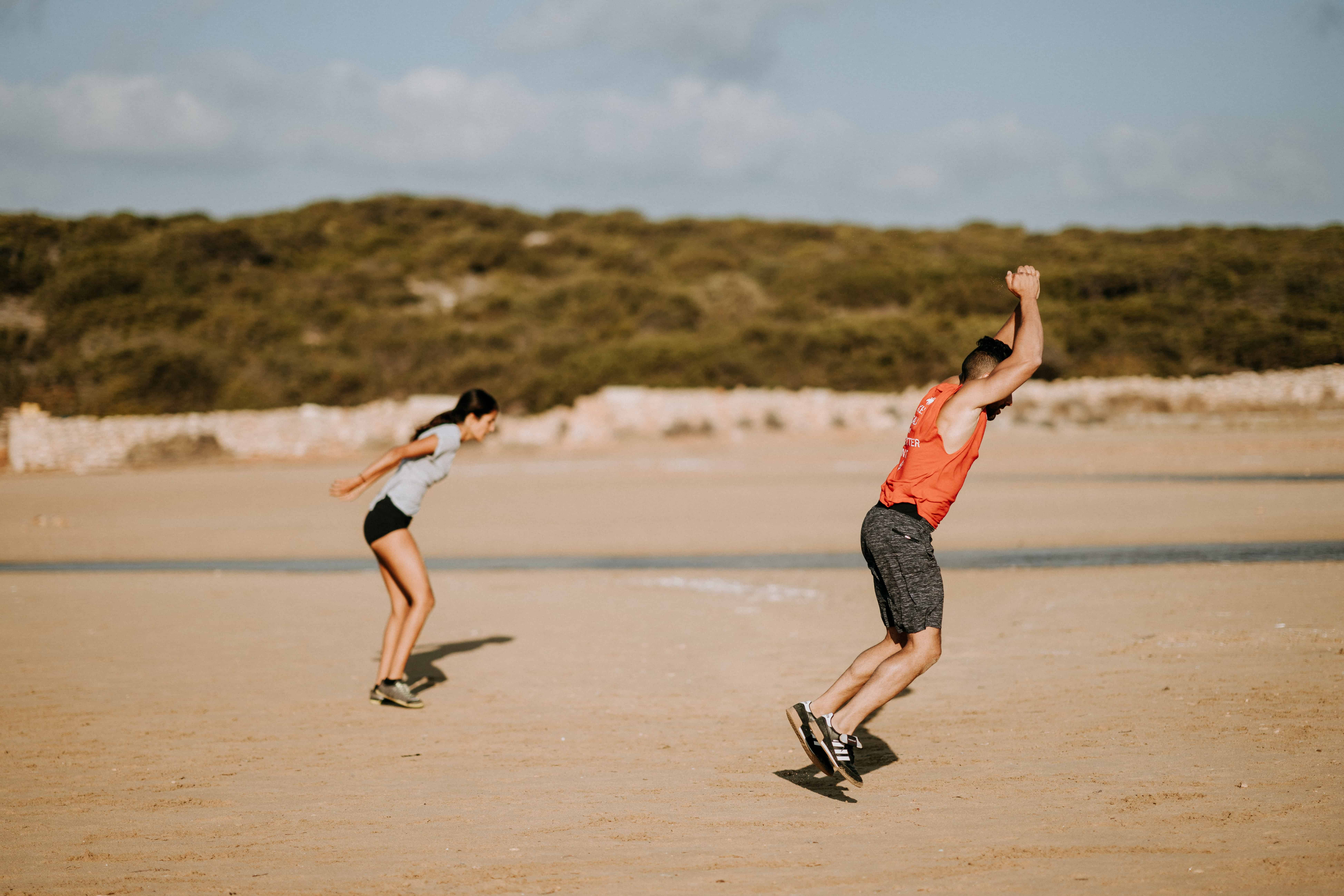The best way to run faster is to run often, but running too much can cause injuries. Combining a running routine with any type of cross-training will keep you injury free on your training plan for longer. Plyometric exercises are one option for runners who want to become stronger and injury-resistant without increasing the number of high-impact activities they perform. In this article, we’ll discuss how plyometric exercises can improve running performance and several exercises to try.

What Are Plyometric Exercises?
Plyometric exercises are low-impact exercises that focus on quickly jumping and landing with a focus on rapid movements. Jumping rope is one example of a plyometric exercise. Other exercises are more complex, but you won’t need any equipment to get in a quality workout.
Why Should You Do Plyometric Exercises?
Every runner strives to run faster, and plyometric workouts can help shave minutes off your next half marathon. Plyometric exercises strengthen muscle fibers, help with VO2 max and can condition a body to handle longer distances. Plyometrics are a great addition to any half-marathon training plan.
How Frequently Should You Do Plyometric Exercises?
Plyometrics take a higher toll on the body than regular stretches. Performing a plyometric exercise too frequently could lead to injuries. Most runners would benefit from one to two plyometric workouts each week. With two days per week, your body will have enough time to recover between workouts while simultaneously strengthening your legs. You avoid plyometric workouts the day before a long run or hard workout. You should also wait until a day after a hard workout or long run to do plyometrics. As a best practice, most runners should avoid running every day.
How Should I Warm Up Before Plyometrics?
Because plyometric exercises involve jumping, they put a strain on the calves, Achilles tendon, hamstrings, and glute muscles. Before doing any plyometric exercises, dynamic stretches like lunches, high knees, and flamingo stretches will prepare you for the workout.
Plyometric Exercises for Beginners
Here are some plyometrics exercises for beginners.
1. Jump Squats
Jump squats add a jump to the regular squat. The jump is inserted your way up from the bent squat position. Focus on quality over quantity – jump as high as you can and land as softly as possible on the balls of your feet.
2. Box Jumps
For this workout, you will need a box of any size that can hold the entirety of your weight. Most gyms have workout boxes or you can buy your own. Your objective is to start in a squat position and thrust yourself forward on top of the box and finish in a slight squat. Runners should step down from the box and continue their repetitions. The height of your selected box will make this exercise easier (shorter box) or more challenging (taller box).
3. Jump Rope
Jumping rope is a great exercise for runners. As we learned as children, just grab the rope handles and use your wrists to move the rope. Jump over the rope as many times as possible or to a set number of reps. Jumping rope is also excellent for heart rate training.
4. Long Jump
The long jump is a useful alternative if you do not have a box. Starting from a stationary position, get into a squat position, swing your arms back, and then thrust your arms forward propelling your jump. Your objective is to cover as much horizontal distance as possible with these jumps while landing on the balls of your feet.
5. Scissor Jumps
Start with your left leg slightly forward and your right leg slightly back. Your right arm should be slightly back, and your left arm should be slightly forward. When you jump, move your legs like a pair of scissors so you land with the left leg slightly forward and the right leg slightly backward. Your arms also switch places in the stance. After landing gently on the ground, repeat this exercise. Don’t bend the knees too much, that’s part of a more advanced move that will be discussed shortly.
Intermediate Plyometric Exercises
Now that you’ve mastered a few moves and generated some small wins, take a look at more intermediate exercises.
1. Jump Tucks
Start in a standing position and jump up in the air. Lift up your knees mid-jump, so they are in front of you. Make sure you land softly on the balls of your feet and repeat the exercise. It may be difficult to land gently at first, but it will get easier if you initially do fewer reps and commit to mastering your form.
2. Jumping Jacks
Start with your arms down to your hips and legs together. Then jump moving your legs apart as much as you can, and lift your hands, to perform a clap over your head. After landing in that position, proceed to another jump where you land in the same way you started. Do as many repetitions as you can.
3. Knees To Chest
For this exercise, start in the plank position. With the palms of your hands resting on the ground, use your arms and legs to keep your chest from hitting the ground. Thrust your legs as close to your chest as possible while keeping your arms in the same place. Then, kick your legs out, so you are back in the plank position.
4. Lunge Knee-Ups
Start in a standing position and move one of your legs back to form a lunge. Once you have that position, thrust the back leg forward and jump with the other leg. While in the air, perform a knee-up with the leg you previously used for your lunge. When you land, reposition the leg you used for the knee-up, so you are back in the same lunge position. After a few reps with one leg, do the same number of reps with the other leg.
5. Plank Jacks
Start in a plank position with your legs almost touching. Then, lift both legs simultaneously while keeping your hands on the ground. Stretch out your legs as wide as you can before they land on the ground. After your feet hit the ground, perform this same routine but get your legs closer together like they were when you started. Perform several reps.
Advanced Plyometric Exercises
Now that you have more plyometric exercises under your belt, it’s time for the big leagues. You will feel these exercises the most, but they are some of the most rewarding exercises to complete.
1. Burpees
Burpees are a classic exercise that work on several muscle groups and is great for cardiovascular stress. Start in a crouched position with the palms of your hands on the ground and your knees tucked. Then, kick out your legs and perform a pushup after getting stationed. After the pushup, thrust your legs back to their previous position and use the momentum to jump upward. After landing on your feet, get back down in the plank position and repeat the exercise.
2. Lunge Jumps
Start in a lunge position and use both of your legs to jump from the ground. While in the air, move your legs, so you land in a lunge with legs swapping positions. If you jumped with your left leg back and your right leg forward, you should land on the ground with your left leg forward and your right leg back. Repeat this exercise several times, ensuring you land in the lunge position each time. You can make this exercise more challenging by holding your arms above you.
3. Pistol Squats
Start in the standing position and balance on one leg. Stretch the other leg forward and get as close to a 90-degree angle as you can. Then, slowly bend the leg on the ground to perform a squat getting closer to the ground. Use this leg to then lift up the rest of your body. After performing 10 to 12 reps on one side, complete the same number of reps on the opposite side. You can go as low as you like. Start with an easy dip in the beginning and challenge yourself to go deeper and add more repetitions as you get comfortable with the exercise.
4. Clapping Push Ups
Get in a pushup position and perform a standard pushup. Push up hard enough with your hands to lift them off the ground. Before your hands hit the ground, perform a clap and reposition them on the way down for your next pushup.
5. Burpees with Jump Tucks
This is a more complicated burpee that deserves its own section. Everything remains the same except for the jump. Instead of simply jumping up and landing on your feet, perform a jump tuck during this jump. This extra step in your burpee adds another layer of complexity it.
Tips for Plyometrics Training
Knowing the right exercises is only the starting point for effective plyometric training. Keep these tips in mind to achieve optimal performance:
- Focus on quality over quantity. It’s always better to do fewer reps of an exercise with better form as it will strengthen the muscles with a lower risk of injury.
- Aim for a 30-minute plyometric workout. Most runners can handle 30 minutes, and it gives you enough time to perform a variety of exercises.
- Group your exercises strategically. Many plyometric workouts feature a set of three exercises. You can repeat sets or go into the new set without repeating previous exercises. Having burpees, clapping pushups and lunge jumps in the same workout would be extremely challenging and demanding. You can space those harder exercises away from each other and use beginner and intermediate exercises to complete each set.
- Make sure you land on the balls of your feet and wear good sneakers. These practices reduce the risk of injury. Don’t do plyometrics every day. Most runners only need one to two plyometric sessions each week.
Incorporating Plyometrics into Your Running Routine
Running every day presents several risks, but a good plyometrics workout can help you gain fitness on your off days. Plyometric exercises complement running efforts and can help you run faster times. Plyometric workouts make a great addition to any half marathon training plan.





